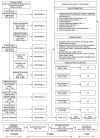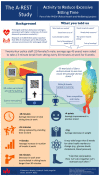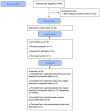A-REST (Activity to Reduce Excessive Sitting Time): A Feasibility Trial to Reduce Prolonged Sitting in Police Staff
- PMID: 35954543
- PMCID: PMC9368451
- DOI: 10.3390/ijerph19159186
A-REST (Activity to Reduce Excessive Sitting Time): A Feasibility Trial to Reduce Prolonged Sitting in Police Staff
Abstract
The aim of this study was to evaluate the acceptability and feasibility of a theory-derived sedentary workplace intervention for police office staff. Twenty-four staff participated in an 8-week intervention (single arm, pre-post design) incorporating an education session, team competition with quick response (QR) codes, team trophy, weekly leaderboard newsletters, a self-monitoring phone app, and electronic prompt tools. The intervention supported participants to reduce and break up their sitting time with three minutes of incidental movement every 30 min at work. Feasibility and acceptability were assessed using mixed methods via the RE-AIM QuEST and PRECIS-2 frameworks. The intervention was highly pragmatic in terms of eligibility, organisation, adherence, outcome, and analysis. It was slightly less pragmatic on recruitment and setting. Delivery and follow-up were more explanatory. Reach and adoption indicators demonstrated feasibility among police staff, across a range of departments, who were demographically similar to participants in previous office-based multi-component interventions. The intervention was delivered mostly as planned with minor deviations from protocol (implementation fidelity). Participants perceived the intervention components as highly acceptable. Results showed improvements in workplace sitting and standing, as well as small improvements in weight and positive affect. Evaluation of the intervention in a fully powered randomised controlled trial to assess behaviour and health outcomes is recommended.
Keywords: QR codes; activity breaks; behaviour change wheel; feasibility; intervention; office workers; police; sitting.
Conflict of interest statement
The authors declare no conflict of interest.
Figures




Similar articles
-
Effectiveness of the multi-component dynamic work intervention to reduce sitting time in office workers - Results from a pragmatic cluster randomised controlled trial.Appl Ergon. 2020 Apr;84:103027. doi: 10.1016/j.apergo.2019.103027. Epub 2020 Jan 10. Appl Ergon. 2020. PMID: 31987512 Clinical Trial.
-
Acceptability and feasibility of a low-cost, theory-based and co-produced intervention to reduce workplace sitting time in desk-based university employees.BMC Public Health. 2015 Dec 24;15:1294. doi: 10.1186/s12889-015-2635-z. BMC Public Health. 2015. PMID: 26703900 Free PMC article.
-
A multi-component intervention to sit less and move more in a contact centre setting: a feasibility study.BMC Public Health. 2019 Mar 12;19(1):292. doi: 10.1186/s12889-019-6615-6. BMC Public Health. 2019. PMID: 30866872 Free PMC article. Clinical Trial.
-
Perceptions of the acceptability and feasibility of reducing occupational sitting: review and thematic synthesis.Int J Behav Nutr Phys Act. 2018 Sep 18;15(1):90. doi: 10.1186/s12966-018-0718-9. Int J Behav Nutr Phys Act. 2018. PMID: 30227861 Free PMC article. Review.
-
Workplace interventions for reducing sitting at work.Cochrane Database Syst Rev. 2018 Dec 17;12(12):CD010912. doi: 10.1002/14651858.CD010912.pub5. Cochrane Database Syst Rev. 2018. PMID: 30556590 Free PMC article.
Cited by
-
A longitudinal study combining the Double Diamond framework and Behavior Change Wheel to co-create a sedentary behavior intervention in police control rooms.J Public Health (Oxf). 2024 Aug 25;46(3):419-429. doi: 10.1093/pubmed/fdae061. J Public Health (Oxf). 2024. PMID: 38702850 Free PMC article.
-
The frail-LESS (LEss sitting and sarcopenia in frail older adults) remote intervention to improve sarcopenia and maintain independent living via reductions in sedentary behaviour: findings from a randomised controlled feasibility trial.BMC Geriatr. 2024 Sep 9;24(1):747. doi: 10.1186/s12877-024-05310-9. BMC Geriatr. 2024. PMID: 39251904 Free PMC article. Clinical Trial.
-
Identifying recruitment strategies to improve the reach of evidence-based health promotion, disease prevention, and disease self-management interventions: a scoping review.Front Public Health. 2025 Apr 1;13:1515042. doi: 10.3389/fpubh.2025.1515042. eCollection 2025. Front Public Health. 2025. PMID: 40290508 Free PMC article.
References
-
- Thorp A.A., Healy G.N., Winkler E., Clark B.K., Gardiner P.A., Owen N., Dunstan D.W. Prolonged Sedentary Time and Physical Activity in Workplace and Non-Work Contexts: A Cross-Sectional Study of Office, Customer Service and Call Centre Employees. Int. J. Behav. Nutr. Phys. Act. 2012;9:128. doi: 10.1186/1479-5868-9-128. - DOI - PMC - PubMed
-
- Wilmot E.G., Edwardson C.L., Achana F.A., Davies M.J., Gorely T., Gray L.J., Khunti K., Yates T., Biddle S.J.H. Sedentary Time in Adults and the Association with Diabetes, Cardiovascular Disease and Death: Systematic Review and Meta-Analysis. Diabetologia. 2012;55:2895–2905. doi: 10.1007/s00125-012-2677-z. - DOI - PubMed
Publication types
MeSH terms
LinkOut - more resources
Full Text Sources

